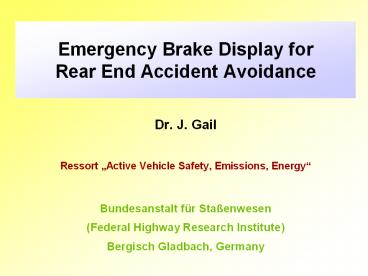Emergency Brake Display for Rear End Accident Avoidance - PowerPoint PPT Presentation
Title:
Emergency Brake Display for Rear End Accident Avoidance
Description:
maximum deceleration of the following car. intuitive display (no learning necessary) ... threshold values corresponding to real braking behaviour ... – PowerPoint PPT presentation
Number of Views:451
Avg rating:3.0/5.0
Title: Emergency Brake Display for Rear End Accident Avoidance
1
Emergency Brake Display forRear End Accident
Avoidance
- Dr. J. Gail
- Ressort Active Vehicle Safety, Emissions,
Energy - Bundesanstalt für Staßenwesen
- (Federal Highway Research Institute)
- Bergisch Gladbach, Germany
2
Content
- requirements for an emergency brake display
- examples
- optimum solution
- criteria for activation / deactivation
- regulations concerned
3
Requirements for anEmergency Brake Display (1)
- fast perception (also by distracted drivers)
- short reaction times
- easy implementation and refitting
- maximum deceleration of the following car
- intuitive display (no learning necessary)
- few levels
4
Requirements for anEmergency Brake Display (2)
- threshold values corresponding to real braking
behaviour - functionality for emergency braking on
low-µ-surfaces - unambiguous display
- not confusing
- minimised effects of habituation
5
Example 1 Increased Light Surface Area and
Intensity
6
Increased Area and Intensity
- pros
- intuitively
- no learning process
- causes adequate brakings of the following driver
(early maximum brake force) - reduced reaction times
- cons
- lights have to be fixed by the drivers eyes
- difficult refitting
- vehicle design
7
Example 2 Integral Brakelight
3rd upper brakelight
G
(? 19 levels)
? too many levels
8
Example 3 Flashing Brakelights
9
Flashing Brakelights
reduction in reaction time (source
DaimlerChrysler)
10
Flashing Brakelights
- pros
- good perception also by distracted drivers
- reduced reaction times
- easy refitting
- cons
- learning process might be necessary
11
Example 4 Flashing Hazard Warning Lights
12
Flashing Hazard Warning Lights
reduction in reaction time (source
DaimlerChrysler)
13
Flashing Hazard Warning Lights
- pros
- good perception
- reduced reaction times
- easy refitting
- cons
- change in colour
- usual meaning warning in case of
- broken down vehicle
- accident
- end of congestion
- automatical switching only if
deceleration gt 1.5 g
14
Example 5 Continuously Shining Rear
Direction-Indicators
- pros
- easy refitting
- cons
- change in colour
- meaning is not intuitively clear
15
Optimum Solution (1)
- keeping the colour coding red
light braking - flashing to achieve best perception by distracted
drivers
(3 Hz to 5 Hz flashing)
16
Optimum Solution (2)
- optional increase in surface area of lower
brakelights additional to flashing upper
brakelight
1)
2)
(3 Hz - 5 Hz)
? best perception intuitive display for
severe braking
17
Criteria for Activation / Deactivation (1)
- threshold deceleration 7 m / s2
- emergency brake assistance system
- anti-lock brake system
- pressure of the brake system / brake force
- change of vehicle velocity (real deceleration)
18
Criteria for Activation / Deactivation (2)
- switching on immediately after detection of
emergency braking - switching off after
- releasing the brake pedal or
- after standstill of the vehicle or
- detection of the end of the severe braking by a
brake assistance / anti-lock braking system - threshold velocity 5 km / h
19
Regulations Concerned
- ECE-R 7, ECE-R 48 and Vienna Convention
- red flashing upper brakelight
- increase in surface area
- definition of activation of brakelights
- changing display during braking
- fixing of switching criteria































